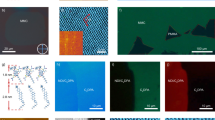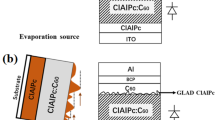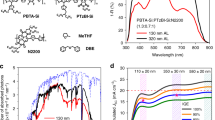Abstract
The power conversion efficiency of organic photovoltaic cells has increased with the introduction of the donor–acceptor heterojunction that serves to dissociate strongly bound photogenerated excitons1. Further efficiency increases have been achieved in both polymer2,3 and small-molecular-mass4 organic photovoltaic cells through the use of the bulk heterojunction (BHJ), where the distance an exciton must diffuse from its generation to its dissociation site is reduced in an interpenetrating network of the donor and acceptor materials. However, the random distribution of donor and acceptor materials in such structures can lead to charge trapping at bottlenecks and cul-de-sacs in the conducting pathways to the electrodes. Here, we present a method for growing crystalline organic films into a controlled bulk heterojunction; that is, the positions and orientations of donor and acceptor materials are determined during growth by organic vapour-phase deposition (OVPD5), eliminating contorted and resistive conducting pathways while maximizing the interface area. This results in a substantial increase in power conversion efficiency compared with the best values obtained by 'random' small-molecular-weight BHJ solar cells formed by high-temperature annealing, or planar double heterojunction photovoltaic cells using the same archetypal materials systems.
This is a preview of subscription content, access via your institution
Access options
Subscribe to this journal
Receive 12 print issues and online access
$259.00 per year
only $21.58 per issue
Buy this article
- Purchase on Springer Link
- Instant access to full article PDF
Prices may be subject to local taxes which are calculated during checkout





Similar content being viewed by others
References
Tang, C. W. Two-layer organic photovoltaic cell. Appl. Phys. Lett. 48, 183–185 (1986).
Yu, G., Gao, J., Hummelen, J. C., Wudl, F. & Heeger, A. J. Polymer photovoltaic cells: enhanced efficiencies via a network of internal donor-acceptor heterojunctions. Science 270, 1789–1791 (1995).
Halls, J. J. M. et al. Efficient photodiodes from interpenetrating polymer networks. Nature 376, 498–500 (1995).
Peumans, P., Uchida, S. & Forrest, S. R. Efficient bulk heterojunction photovoltaic cells using small-molecular-weight organic thin films. Nature 425, 158–162 (2003).
Baldo, M. et al. Organic vapor phase deposition. Adv. Mater. 10, 1505–1514 (1998).
Peumans, P., Bulovi, V. & Forrest, S. R. Efficient photon harvesting at high optical intensities in ultrathin organic double-heterostructure photovoltaic diodes. Appl. Phys. Lett. 76, 2650–2652 (2000).
Shtein, M., Mapel, J., Benziger, J. B. & Forrest, S. R. Effects of film morphology and gate dielectric surface preparation on the electrical characteristics of organic-vapor-phase-deposited pentacene thin-film transistors. Appl. Phys. Lett. 81, 268–270 (2002).
Shtein, M., Peumans, P., Benziger, J. B. & Forrest, S. R. Micropatterning of small molecular weight organic semiconductor thin films using organic vapor phase deposition. J. Appl. Phys. 93, 4005–4016 (2003).
Shtein, M., Gossenberger, H. F., Benziger, J. B. & Forrest, S. R. Material transport regimes and mechanisms for growth of molecular organic thin films using low-pressure organic vapor phase deposition. J. Appl. Phys. 89, 1470–1476 (2001).
Venables, J. A., Spiller, G. D. T. & Hanbücken, M. Nucleation and growth of thin films. Rep. Prog. Phys. 47, 399–459 (1984).
Klug, H. P. & Alexander, L. E. X-ray Diffraction Procedures (Wiley, New York, 1974).
Forrest, S. R. Ultrathin organic films grown by organic molecular beam deposition and related techniques. Chem. Rev. 97, 1793–1896 (1997).
Makinen, A. J., Melnyk, A. R., Schoemann, S., Headrick, R. L. & Gao, Y. Effect of crystalline domain size on the photophysical properties of thin organic molecular films. Phys. Rev. B 60, 14683–14687 (1999).
Xue, J., Uchida, S., Rand, B. P. & Forrest, S. 4.2% efficient organic photovoltaic cells with low series resistances. Appl. Phys. Lett. 84, 3013–3015 (2004).
Hoppe, H. & Sariciftci, N. S. Organic solar cells: an overview. J. Mater. Res. 19, 1924–1945 (2004).
Rostalski, J. & Meissner, D. Photocurrent spectroscopy for the investigation of charge carrier generation and transport mechanisms in organic p/n-junction solar cells. Solar Energy Mater. Solar Cells 63, 37–47 (2000).
Sharma, G. D. & Saxena, D. Characterization of ITO/ZnPc/CHR/In p-n junction photovoltaic device using J-V, C-V and photoaction measurements. J. Mater. Sci. 10, 539–544 (1999).
Uchida, S., Xue, J., Rand, B. P. & Forrest, S. Organic small molecule solar cells with a homogeneously mixed copper phthalocyanine: C60 active layer. Appl. Phys. Lett. 84, 4218–4220 (2004).
Acknowledgements
We thank J. Xue, S. Uchida, R. Holmes, B. Rand and P. Peumans for discussions. We also thank the US Air Force Office of Scientific Research, the National Renewable Energy Laboratory and Global Photonic Energy Corporation for financial support.
Author information
Authors and Affiliations
Corresponding author
Ethics declarations
Competing interests
The authors declare no competing financial interests.
Rights and permissions
About this article
Cite this article
Yang, F., Shtein, M. & Forrest, S. Controlled growth of a molecular bulk heterojunction photovoltaic cell. Nature Mater 4, 37–41 (2005). https://doi.org/10.1038/nmat1285
Received:
Accepted:
Published:
Issue Date:
DOI: https://doi.org/10.1038/nmat1285
This article is cited by
-
Macro- and atomic-scale observations of a one-dimensional heterojunction in a nickel and palladium nanowire complex
Nature Communications (2022)
-
Shape-engineering of organic heterostructures via a sequential self-assembly strategy for multi-channel photon transportation
Nano Research (2022)
-
Organic magnetoelectric and optomagnetic couplings: perspectives for organic spin optoelectronics
NPG Asia Materials (2021)
-
Random Nanowire Arrays Spontaneously Formed via Vacuum Deposition for Enhancing Light Extraction from Inverted Top-Emitting Organic Light-Emitting Diodes
Fibers and Polymers (2021)
-
Effect of Annealing Induced Morphology on Mobility of Copper Phthalocyanine Thin Films
Journal of Inorganic and Organometallic Polymers and Materials (2020)



